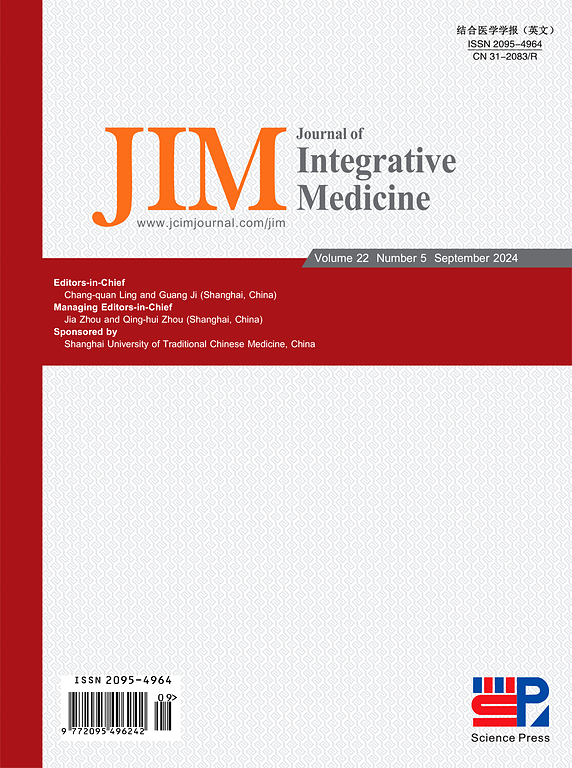白芷的细胞保护活性研究黑客。基于同步辐射的傅里叶变换红外微光谱法评价乙醇提取物。
IF 4
2区 医学
Q1 INTEGRATIVE & COMPLEMENTARY MEDICINE
引用次数: 0
摘要
目的:采用同步辐射傅立叶变换红外(SR-FTIR)微光谱法研究80%乙醇制备的白芍提取物的细胞保护作用,并测定其植物化学成分。方法:分别采用气相色谱-质谱法和液相色谱-质谱法对PPE中挥发物和多酚类化合物进行表征。PPE的抗氧化能力通过化学和细胞为基础的试验进行评估。采用SR-FTIR微光谱技术,通过鉴定过氧化叔丁基(tBuOOH)诱导的RAW264.7细胞氧化损伤中大分子组成的变化,评价PPE的细胞保护作用。结果:PPE中共检出48种挥发性化合物和28种多酚类成分。PPE通过清除tbuoh诱导的RAW264.7细胞氧化损伤中的细胞内活性氧,显示出较高的抗氧化活性潜力。PPE处理还能显著保护RAW264.7细胞免受tbuoh诱导的毒性,恢复细胞活力。SR-FTIR分析显示,buooh增加了RAW264.7细胞的脂质和酯质含量。PPE通过降低tBuOOH在RAW264.7细胞中升高的脂质和酯类脂质化合物的水平发挥细胞保护作用。这些发现表明PPE具有抑制内源性活性氧的能力,具有细胞保护潜能。结论:本研究扩展了对PPE植物化学及其抗氧化和细胞保护作用的现有认识。这些发现支持使用SR-FTIR显微光谱来确定天然产物的细胞保护作用。PPE提取物可能是针对预防氧化应激相关疾病的新疗法和营养保健品的候选化合物。请在本文中注明:Dunkhunthod B, Thumanu K, Teethaisong Y, Sittisart P, Sittisart P。黑客。基于同步辐射的傅里叶变换红外微光谱法评价乙醇提取物。集成医学[J];打印前Epub。本文章由计算机程序翻译,如有差异,请以英文原文为准。
Cytoprotective activity of Pogonatherum paniceum (Lam.) Hack. ethanolic extract evaluated by synchrotron radiation-based Fourier transform infrared microspectroscopy
Objective
The present study investigated the cytoprotective effects of a Pogonatherum paniceum extract prepared with 80% ethanol (PPE) using synchrotron radiation-based Fourier transform infrared (SR-FTIR) microspectroscopy and determined its phytochemical profile.
Methods
The volatile and polyphenolic compounds in PPE were characterized using gas chromatography–mass spectrometry and liquid chromatography–mass spectrometry, respectively. The antioxidant capacity of PPE was evaluated using chemical and cell-based assays. The SR-FTIR microspectroscopy was performed to evaluate the cytoprotective effect of PPE by identifying changes in macromolecule composition in tert-butyl hydroperoxide (tBuOOH)-induced oxidative damage in RAW264.7 cells.
Results
A total of 48 volatile compounds and 28 polyphenol components were found in PPE. PPE exhibited a high potential for antioxidant activity by scavenging the intracellular reactive oxygen species in tBuOOH-induced oxidative damage in RAW264.7 cells. PPE treatment also significantly protected RAW264.7 cells against tBuOOH-induced toxicity and restored cell viability. The SR-FTIR analysis revealed that tBuOOH increased the lipid and ester lipid content in RAW264.7 cells. The PPE exerted a cytoprotective effect by decreasing the levels of lipid and ester lipid compounds that had been elevated by tBuOOH in RAW264.7 cells. These findings indicate that PPE has cytoprotective potential due to its ability to inhibit endogenous reactive oxygen species.
Conclusion
This study extends the current knowledge on the phytochemistry of PPE and its antioxidant and cytoprotective effects. These findings support the use of SR-FTIR microspectroscopy to determine the cytoprotective effects of natural products. PPE extract may be a candidate compound for new therapeutics and nutraceuticals that target the prevention of oxidative stress-associated diseases.
Please cite this article as: Dunkhunthod B, Thumanu K, Teethaisong Y, Sittisart P, Sittisart P. Cytoprotective activity of Pogonatherum paniceum (Lam.) Hack. ethanolic extract evaluated by synchrotron radiation-based Fourier transform infrared microspectroscopy. J Integr Med. 2025; 23(2): 182–194.
求助全文
通过发布文献求助,成功后即可免费获取论文全文。
去求助
来源期刊

Journal of Integrative Medicine-Jim
Medicine-Complementary and Alternative Medicine
CiteScore
9.20
自引率
4.20%
发文量
3319
期刊介绍:
The predecessor of JIM is the Journal of Chinese Integrative Medicine (Zhong Xi Yi Jie He Xue Bao). With this new, English-language publication, we are committed to make JIM an international platform for publishing high-quality papers on complementary and alternative medicine (CAM) and an open forum in which the different professions and international scholarly communities can exchange views, share research and their clinical experience, discuss CAM education, and confer about issues and problems in our various disciplines and in CAM as a whole in order to promote integrative medicine.
JIM is indexed/abstracted in: MEDLINE/PubMed, ScienceDirect, Emerging Sources Citation Index (ESCI), Scopus, Embase, Chemical Abstracts (CA), CAB Abstracts, EBSCO, WPRIM, JST China, Chinese Science Citation Database (CSCD), and China National Knowledge Infrastructure (CNKI).
JIM Editorial Office uses ThomsonReuters ScholarOne Manuscripts as submitting and review system (submission link: http://mc03.manuscriptcentral.com/jcim-en).
JIM is published bimonthly. Manuscripts submitted to JIM should be written in English. Article types include but are not limited to randomized controlled and pragmatic trials, translational and patient-centered effectiveness outcome studies, case series and reports, clinical trial protocols, preclinical and basic science studies, systematic reviews and meta-analyses, papers on methodology and CAM history or education, conference proceedings, editorials, commentaries, short communications, book reviews, and letters to the editor.
Our purpose is to publish a prestigious international journal for studies in integrative medicine. To achieve this aim, we seek to publish high-quality papers on any aspects of integrative medicine, such as acupuncture and traditional Chinese medicine, Ayurveda medicine, herbal medicine, homeopathy, nutrition, chiropractic, mind-body medicine, taichi, qigong, meditation, and any other modalities of CAM; our commitment to international scope ensures that research and progress from all regions of the world are widely covered. These ensure that articles published in JIM have the maximum exposure to the international scholarly community.
JIM can help its authors let their papers reach the widest possible range of readers, and let all those who share an interest in their research field be concerned with their study.
 求助内容:
求助内容: 应助结果提醒方式:
应助结果提醒方式:


